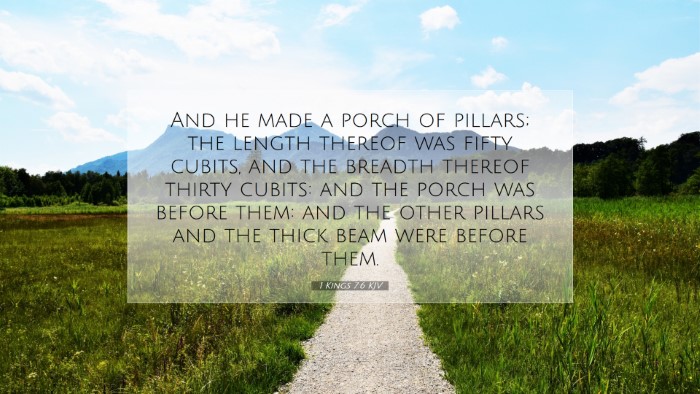Commentary on 1 Kings 7:6
1 Kings 7:6 states, "And he made a porch of pillars; the length thereof was fifty cubits, and the breadth thereof thirty cubits: and the porch was before them: and the other pillars and the thick beam were before them."
This verse describes the construction of the porch of the house that Solomon built, a significant aspect of the overall structure of the temple. The porch, or portico, serves as an introduction to the interior of the temple, illustrating both physical and spiritual access to the divine presence.
Insights from Commentaries
Matthew Henry's Commentary
According to Matthew Henry, the porch is a symbol of the access to God through Christ. The dimensions of the porch—fifty cubits in length and thirty cubits in breadth—signify a spacious invitation for worshippers to draw nearer to the divine. Henry emphasizes that the porch serves both as a physical space and as a representation of God’s welcoming presence.
- Significance of Dimensions: The proportions suggest divine order and perfection, a theme consistent throughout the temple’s architecture.
- Symbolism of the Porch: The porch symbolizes the threshold between the secular and sacred, illustrating the importance of preparing oneself for worship.
Albert Barnes' Notes
Albert Barnes provides a detailed analysis of the construction attributes of the porch, noting that the grandeur and scale of Solomon’s temple reflect the magnificence of God's design and purpose. Barnes suggests the porch played a crucial role in enhancing the aesthetic experience of entering the temple.
- Architectural Details: Barnes notes that the use of pillars was not merely structural but also symbolic, representing strength and stability.
- Function of the Porch: The porch acted as a gathering space for worshippers, underscoring the communal aspect of worship in ancient Israel.
Adam Clarke's Commentary
Adam Clarke's observations delve into the construction techniques and materials used in the porch. Clarke highlights that the weight and grandeur of the pillars signify the strength of God's covenant with Israel. Furthermore, he remarks on the artistic elements that adorned the porch, suggesting that beauty and craftsmanship were part of the expression of faith.
- Emphasis on Craftsmanship: Clarke emphasizes the importance of skillful labor in creating spaces that honor God, aligning with a broader theological theme of excellence in service.
- Theological Implications: The porch represents God's invitation to humanity; it is a reminder of the access believers have to God through faith.
Theological Reflections
From this passage, several key theological themes emerge:
- God’s Desire for Fellowship: The porch symbolizes God's longing for relationship with His people. It serves as an access point for worship and communion.
- Preparation for Sacred Encounter: The design and layout compel worshippers to prepare for a significant encounter with the Holy.
- Integration of Beauty and Function: The physical structure showcases the intertwining of aesthetic beauty and worship, revealing that God is worthy of the finest offerings.
Practical Applications
In light of this commentary, we can derive practical lessons for contemporary religious practice:
- Creating Sacred Spaces: Church leaders are encouraged to design spaces that foster a sense of reverence and inspire worship.
- Encouraging Communal Worship: The communal aspect of the porch reminds pastors to foster community and collective worship experiences.
- Embracing Excellence: Just as the porch was built with care, worshipers today are called to offer their best—both in their personal lives and in communal worship settings.
Conclusion
In summary, 1 Kings 7:6 serves as a profound reflection on the nature of worship and God's invitation to relationship through careful design and architecture. It extends beyond mere physical structure; it invites theological contemplation and practical application for modern believers seeking to honor God in their lives and worship.


